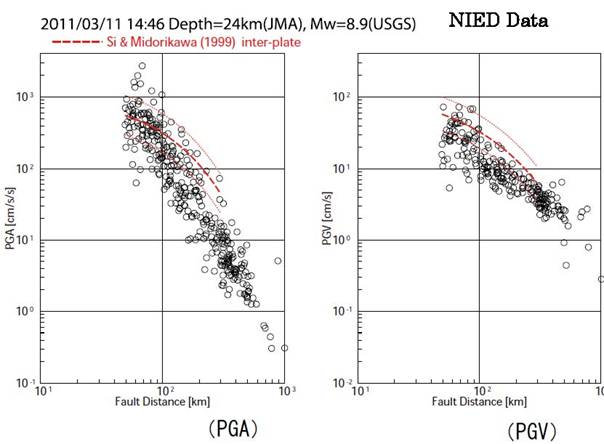As of March 15, 414 dams were inspected. 10 embankment dams suffered from shallow cracking on the crest. But all these dams function well with no problems. At two asphalt concrete rockfill dams, small cracking occurred at the face. It sustains water with no problems. A small slope failure occurred on the reservoir at a concrete gravity dam, but it is not serious. There are still some dams not accessible which are in the earthquake affected area. Fujinuma Dam, a 17.5m high earthfill dam is reported to have failed according to news media. Its crest length is 133m and the reservoir capacity is 1.5 million m3. The information on this breach is under investigation and will be reported later.
Most dams above mentioned are located more than 140km away from the epicenter. The fault distance is about from 100km to 200km. Accelerations are recorded at about 50 dams. PGA at dam foundations ranges from around 0.02g to 0.3g. 0.5g was measured at one dam. But its reliability of the record is studied by relevant experts. The duration of the motions was very long, 90 to 180 seconds. Numerous aftershocks followed.
PGA shown in Fig. 1 is NIED data, not from dams. NIED stands for “National Research Institute for Earth Science and Disaster.” The PGA at the fault distance of 100km ranges from 0.1g to 0.6g with the average of 0.2g. The experience of Jananese experts shows that PGA at dam foundations is about half of PGA of the NIED ground motions, when the distance is the same. The reason is that the instruments of NIED are mostly placed on soils, where the dam foundations are mostly rock.
Fig. 1 Attenuation of PGA (cm/s/s) of the horizontal component and PGV (cm/s); PGA is the measured value and PGV is the computed value converted for the hard foundation with the shear velocity of 600m/s. Data source: NIED

(Provided by Mr. Norihisa Matsumoto of JCOLD on March 16,2011)







